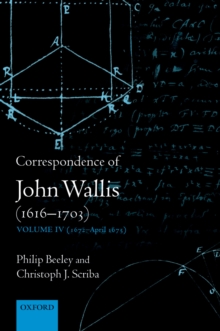
Correspondence of John Wallis (1616-1703) : Volume III (October 1668-1671) PDF
by Philip Beeley, Christoph J. Scriba
Part of the The Correspondence of John Wallis 1616-1703 series
Description
Containing many previously unpublished letters, this third volume of a six volume collection of the complete correspondence of John Wallis (1616-1703), documents an important period in the history of the Royal Society and the University of Oxford.
By providing access to these letters, this painstakingly crafted edition will enable readers to gain a deeper and richer awareness of the intellectual culture on which the growth of scientific knowledge in early modernEurope was based. Wallis was Savilian Professor of Geometry of Oxford from 1649 until his death, and was a founding member of the Royal Society and a central figure in the scientific and intellectual history of England.
In the period covered Wallis is engaged in scientific debates on techniques for determining areas contained by curves (quadratures) and figures (cubatures), as well as on the theory of motion and the nature of the tides.
He also continues to attack the mathematical undertakings of Thomas Hobbesand to respond to attacks which the philosopher in turn levels against him.
We also find evidence for the consolidation of mathematics as an academic discipline in the University of Oxford just fifty years after the establishment of the first mathematical lecturerships.
Wallis is called upon more thanonce to deliver ceremonial lectures on mathematical topics to foreign dignitaries visiting the University. At the same time the volume allows us to witness the beginnings of a remarkable development in mathematical publishing.
Many of Wallis's letters to Henry Oldenburg, secretary of the Royal Society, on a variety of topics in the mathematical and physical sciences, are transformed into articles and published in Oldenburg's journal, the Philosophical Transactions.
Part of the reason for this development also becomes clear in the letters: the long and costly process of publishing mathematical bookssuch as Wallis's three part Mechanica: sive de motu.
This volume not only signals the modernization of mathematics in the second half of the seventeenth century but we also see two new figures emerge for the first time, whose careers are in different ways closely associated with Wallis: Isaac Newtonand Gottfried Wilhelm Leibniz.
Information
-
Download - Immediately Available
- Format:PDF
- Publisher:OUP Oxford
- Publication Date:03/05/2012
- Category:
- ISBN:9780191628887
Information
-
Download - Immediately Available
- Format:PDF
- Publisher:OUP Oxford
- Publication Date:03/05/2012
- Category:
- ISBN:9780191628887










